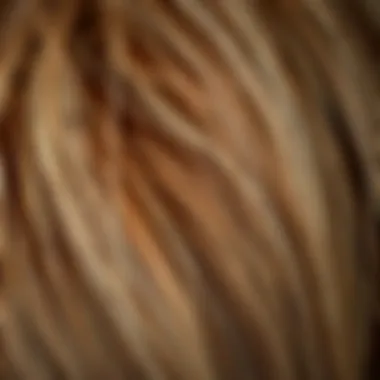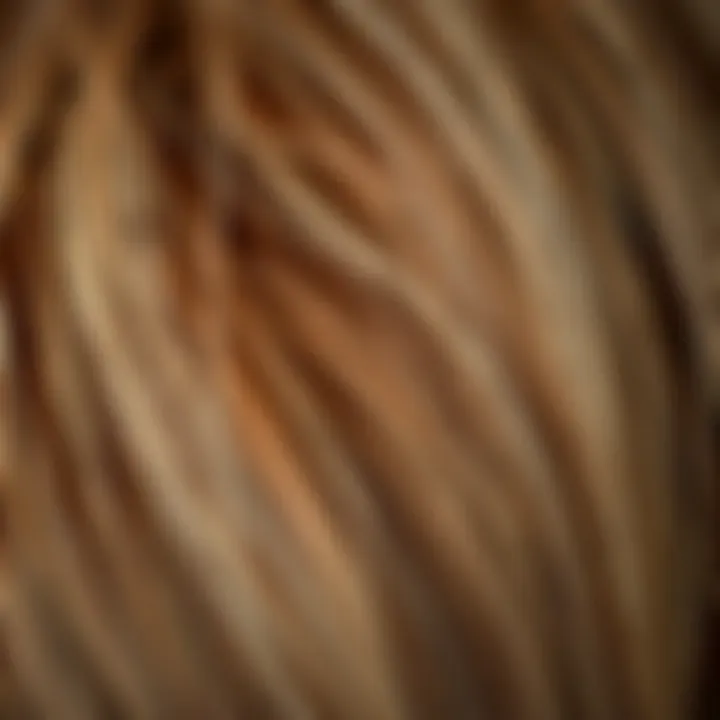Effective Solutions for Hair Bumps


Intro
Hair bumps can be more than just a cosmetic nuisance; they often reflect underlying conditions that may require consideration. These bumps can appear anywhere on the scalp and may arise from a variety of factors including irritation, ingrown hairs, or folliculitis. Understanding the nature of these bumps is essential for effective treatment and prevention. It’s not just about aesthetics; smooth hair contributes to a person’s physical and mental well-being.
By exploring the causes and implementing targeted strategies, individuals can address hair bumps head-on. This guide offers a comprehensive approach, inviting health professionals, wellness coaches, nutritionists, and fitness trainers to enhance their knowledge on the topic. Readers can expect to gain insights into practical techniques for removal and preventive measures that promote a healthy scalp and a confident appearance.
With this foundational knowledge in mind, let’s delve deeper into the health benefits associated with maintaining smooth hair.
Understanding Hair Bumps
Understanding hair bumps is essential for anyone seeking to maintain their hair's health and appearance. These bumps are not merely cosmetic nuisances; they often signal underlying issues that, if unaddressed, can lead to more severe complications. By delving into the characteristics, causes, and demographic impacts of hair bumps, this section sets the stage for the effective strategies later discussed in the article. A solid grasp of what hair bumps are can empower individuals to take charge of their hair care. It’s all about prevention and finding the right solutions, tailored to one's specific needs.
Definition of Hair Bumps
Hair bumps, commonly referred to as folliculitis or ingrown hairs, are small, raised, red or white patches situated around hair follicles. They can make the skin appear uneven and create discomfort. Often the result of a hair that curves back and grows into the skin, hair bumps can occur anywhere hair grows on the body. Understanding this definition is key because it highlights that hair bumps are not just a temporary aesthetic issue but indicate potential irritation or inflammation.
Common Causes of Hair Bumps
Hair bumps can arise from various factors, each contributing uniquely to the discomfort and appearance of the skin.
Ingrown hairs
Ingrown hairs are a frequent culprit behind hair bumps. They occur when a strand of hair grows sideways instead of rising through the skin. When this happens, the body can react by inflaming the area around the follicle, leading to painful red bumps. This specific aspect is particularly relevant because it’s often associated with improper hair removal practices, such as shaving. A key characteristic of ingrown hairs is their tendency to recur, making them a popular subject in discussions around skin care difficulties. One major advantage of recognizing them early is that they can often be treated effectively with home remedies, but there are situations where severe cases may require medical intervention.
Styles that cause tension
Certain hair-styling practices can contribute to the development of hair bumps. Tight hairstyles such as braids or ponytails can put pressure on hair follicles, causing inflammation. This aspect is crucial because it points to lifestyle choices that directly impact hair health. A key characteristic of this tension is that it can lead to additional hair loss over time, creating a cycle that many individuals find themselves caught in. The unique feature of this causes is that it's entirely preventable; making simple adjustments, like alternating hairstyles, can yield significant improvements in overall hair health.
Chemical reactions
Chemical reactions from hair products or treatments, such as dyes and styling creams, can also lead to hair bumps. Harsh components can irritate the skin and follicles. This aspect is important because, in our pursuit of aesthetic improvements, sometimes the chemicals we use can work against us. A key characteristic of chemical reactions is their variable impact on different skin types and sensitivities. A unique feature of this cause is that it calls for a more mindful selection of hair products, ensuring that they are suitable for one’s unique hair and skin type; this allows individuals to minimize potential adverse effects and promote healthier hair.
Who is Most Affected?
Understanding who is most affected by hair bumps can help target preventive measures more effectively. Hair bumps are often seen in people with curly or coarse hair, particularly those who frequently shave or groom their body hair. However, they can affect anyone regardless of hair texture. Additionally, individuals who have a history of skin conditions, such as acne or eczema, may also be more vulnerable. Young adults and teens may find themselves particularly affected given their experimentation with styles and products, making it essential to focus on education about proper hair and skin care at this stage.
"Identifying hair bumps early allows for better management and recovery, turning a frustrating experience into a learning opportunity."
Hair bumps may seem small, but understanding their definition, causes, and demographics helps create a solid foundation for the strategies that follow in this article.
Practical Techniques for Removal
Addressing hair bumps effectively requires a careful look at practical techniques aimed at their removal. These methods are crucial not only for easing discomfort but also for restoring the smoothness of the hair's appearance. The key is to choose techniques tailored to both the cause of the bumps and individual skin sensitivities. Moreover, by understanding and utilizing a mix of topical treatments, natural remedies, and supportive measures, one can pave the way to healthier hair without those pesky bumps.
Topical Treatments
Use of cortisone creams
Cortisone creams are a popular choice when looking to alleviate inflammation and itching associated with hair bumps. These topical corticosteroids work by reducing inflammation, making the bumps less noticeable. Their key characteristic is the ability to provide quick relief—often within a few days—making them an attractive option for those seeking immediate results. However, it is vital to use these creams with caution as overuse can lead to skin thinning or irritation. The unique feature of cortisone creams lies in their localized action, which ensures that the treatment is delivered precisely where needed, effectively minimizing side effects throughout the rest of the skin.
Exfoliating agents
Exfoliating agents, such as salicylic acid or glycolic acid, offer another approach to dealing with hair bumps. These substances gently slough off dead skin cells, preventing hair follicles from becoming clogged. This is particularly beneficial as clogged follicles are often a contributor to ingrown hairs or bumps. What makes these exfoliants favorable is their dual action: they not only clear existing bumps but also help in preventing their recurrence by promoting cell turnover. However, they require consistent usage to see long-term effects. Also, individuals with sensitive skin may need to tread lightly, as aggressive exfoliation can provoke irritation.
Cold Compress Methods
Utilizing cold compress methods can be a simple yet effective strategy for relieving the pain and inflammation that hair bumps can cause. Applying a cold pack to the affected area helps to constrict blood vessels, thereby reducing swelling and providing comfort. Moreover, this method is particularly appealing because it requires no special products and can be done at home with common materials. Just a simple ice pack wrapped in a cloth can work wonders. However, caution should be taken to avoid placing ice directly onto the skin for extended periods, as this may lead to ice burns.


Natural Remedies
Aloe vera applications
Aloe vera has long been celebrated for its soothing properties, making it a recommended natural remedy for hair bumps. This wonder plant offers hydration and nourishment while helping to minimize inflammation. The key characteristic of aloe vera is its versatility; it can be applied as a gel or incorporated into lotions. As a beneficial choice, aloe vera not only addresses existing bumps but also hydrates the skin, promoting overall health. However, it’s important to ensure the use of pure aloe vera products to avoid additives that may cause irritation.
Tea tree oil use
Tea tree oil stands out for its antibacterial traits, making it a powerful ally against hair bumps, especially those caused by infections. Its key feature lies in its ability to treat skin ailments while simultaneously soothing inflammation. Thus, using tea tree oil can lead to a reduction in bumps and an improved skin texture. Nevertheless, it must be diluted before topical application to prevent skin irritation, particularly for those with sensitive skin. The right proportion is crucial to maximize benefits.
When to Seek Professional Help
It's essential to recognize when to seek professional assistance in the battle against hair bumps. If the bumps persist despite home treatments, or if they become severe, red, and painful, consulting a dermatologist is advisable. Medical professionals can offer tailored advice and may prescribe treatments that are stronger than over-the-counter options. Furthermore, if you notice any signs of infection, such as pus or excessive swelling, prompt medical attention is critical to prevent further complications.
Prevention of Hair Bumps
When it comes to hair bumps, a stitch in time saves nine. Prevention is the name of the game here. It's perhaps easier than trying to remedy bumps once they’ve set in. Taking proactive steps can greatly diminish the frequency and severity of these bothersome skin irritations.
Selecting Appropriate Hair Products
Chemical-free shampoos
Chemical-free shampoos are often touted as a safe bet for those looking to keep their scalps happy. The key characteristic here is that they avoid harsh substances like sulfates, parabens, and synthetic fragrances which can lead to irritation. By opting for these gentle cleansers, you're giving your hair a fighting chance against bumps. Their unique feature, typically made from natural ingredients, offers a dual benefit: cleaning your hair without causing undue stress to the scalp. However, be mindful that some could be pricier as they often use high-quality, ethically sourced components.
Lightweight conditioners
When it comes to conditioning, lightweight conditioners shine as user-friendly options to avoid overloading your hair. These products are known for their ability to hydrate without weighing your strands down. Because they don't leave a heavy residue, they help ensure that hair follicles do not get clogged. Unlike their heavier counterparts, these conditioners are less likely to contribute to irritation or equate to those dreaded hair bumps. Yet, for individuals with particularly dry hair, more intensive treatments might be needed occasionally; finding the right balance is essential.
Mindful Hair Styling Techniques
Avoiding tight hairstyles
Avoiding tight hairstyles is critical to reducing stress on the scalp. The defining trait here is their ability to prevent tension that might lead to inflammation and subsequent bumps. Styles like tight ponytails or braids can pull on hair follicles, setting the stage for bumps to sprout. Notably, this technique can be a game-changer; wearing your hair loose sometimes provides follicles with the respite they need. Nevertheless, one might argue that some styling might require additional effort to maintain a neat appearance without tightening the hair excessively.
Regular hair breaks
Integrating regular hair breaks into your routine could serve as a much-needed pause for your scalp. The core idea is allowing your hair and scalp to recuperate from the stress placed upon them by styling. Such breaks can lead to improved blood flow and promote healthier hair growth and condition. While it’s tempting to sport your favorite styles daily, consider giving your hair a rest once in a while. Balance is key here, as some may find they can style lightly while still giving the scalp a breather.
Proper Hair Removal Practices
Exfoliating the skin
Incorporating exfoliating the skin into your routine can significantly aid in bump prevention. The central aspect of exfoliation is the removal of dead skin cells that can trap hairs and lead to ingrown bumps. Using gentle exfoliants can keep the scalp clear, promoting a healthier environment for hair growth. Regular exfoliation not only improves the condition of your skin but also encourages new hair to break through smoothly. Caution is advised, though; over-exfoliating can irritate the skin, making it imperative to find a suitable frequency that works for you.
Using sterilized tools
Last but not least, using sterilized tools is non-negotiable for anyone serious about bump prevention. Whether it's scissors or razors, the importance of cleanliness can't be overstressed. Utilizing sterile tools greatly diminishes the risk of infection and irritation post-hair removal, keeping hair follicles clear and free from bumps. While convenience might be tempting, don't be fooled—cutting corners here could result in skin problems. Clearly, those ten seconds spent sanitizing tools could save hours of discomfort later down the line.
"An ounce of prevention is worth a pound of cure."
By integrating these prevention strategies, individuals can take significant steps towards maintaining clear, healthy scalps while minimizing the occurrence of hair bumps.
Lifestyle Adjustments to Consider
When it comes to tackling hair bumps, lifestyle adjustments are not just beneficial; they can be essential. These changes can influence how our hair grows and looks, really making a mark on the overall health of our hair and actually help minimize those pesky bumps. From what we eat to how we handle stress, every little aspect plays a role. Taking a holistic view allows individuals to find long-term relief from hair bumps, while also boosting overall well-being.
Dietary Choices for Healthy Hair
Incorporating vitamins A and E


Including vitamins A and E into your diet is more than a passing trend; it is foundational for hair health. Vitamin A is key in cell growth, and cell growth is vital for hair follicles. Without adequate vitamin A, you could find your locks looking lackluster and possibly experience more hair bumps as a result of weaker hair roots.
What makes vitamin E so special? This vitamin acts as a powerful antioxidant, protecting skin cells from oxidative stress. This protection extends to your scalp and hair follicles, possibly reducing inflammation that might lead to bumps. Adding foods like carrots, sweet potatoes for vitamin A, and avocados, nuts for vitamin E can be a game changer in keeping hair healthy.
- Benefits of Vitamins A and E:
- Drawbacks:
- Promote hair growth
- Aid in maintaining a healthy scalp
- Overconsumption can lead to toxicity, especially with vitamin A, so moderation is the key.
Hydrating the body
Staying hydrated might sound basic, but its impact on hair health is far from trivial. Water is involved in every bodily function, including nourishing hair follicles. Hydration improves blood circulation in the scalp, meaning nutrients reach the follicle more effectively. If you're dehydrated, your hair could become brittle, leading to those unwanted bumps.
Moreover, when the body is well-hydrated, it can help keep skin, including the skin on your scalp, supple and in balance. That might just translate into fewer bumps and irritations, which is exactly what we need keep worries at bay.
- Key characteristics of Hydration:
- Considerations:
- Facilitates nutrient distribution
- Promotes healthy scalp conditions
- Limit caffeinated and alcoholic beverages which can dehydrate; instead, reach for water or herbal teas.
Stress Management Techniques
Meditation practices
Meditation is powerful. It not only works wonders for the mind but also plays a significant role in minimizing hair bumps. Elevated stress levels can trigger a myriad of skin issues including inflammation, which could lead to bumps. Practicing meditation can reduce stress responses and may help keep your scalp calm and irritation-free.
A daily practice can contribute positively to emotional well-being, leaving behind a more relaxed individual. Plus, the benefits aren't just short-term; consistent meditation contributes to long-lasting improvements in general stress management. There is also an element of mindfulness in this practice that encourages one to listen to their body, leading to better choices in hair care and health overall.
- Unique aspect:
- Considerations:
- It's accessible to anyone, whether you have a few minutes or a whole hour.
- Finding a quiet space can be challenging at times, but even a few moments can help.
Mindful physical activity
Physical activity, when done mindfully, can be a powerful ally in combating hair bumps. Exercise promotes blood flow, which translates into better nutrient delivery to the scalp. Engaging in activities that focus on body awareness, such as yoga or tai chi, can also contribute to reducing tension. Unlike high-intensity workouts, mindful movements promote relaxation and encourage a focus on breathing.
What stands out about mindful physical activities is their dual benefit; not only do they alleviate stress, but they also improve physical health. Enhanced circulation combined with stress relief lays a solid foundation for healthier hair growth and possibly minimizes hair bumps.
- Key features:
- Considerations:
- Encourages mind-body connection
- Promotes relaxation through movement
- It may require more commitment to fall into a routine but the investment can yield long-term benefits.
Ultimately, making mindful adjustments to your lifestyle is about creating a balance that fosters a healthier environment for your hair.
The Psychological Impact of Hair Bumps
Hair bumps can often carry a weight that goes beyond skin deep. When one ponders the significance of hair appearance, they grapple with aspects of self-image and the intricate relationship between physical traits and emotional well-being. It's not just about having smooth locks; it extends into the realms of confidence and personal identity. The physical manifestations, such as hair bumps, can stir feelings of self-consciousness, leading individuals to alter their behavior, from avoiding social interactions to feeling less inclined to express themselves freely.
Self-Image and Confidence
The way we perceive ourselves plays a crucial role in our overall psychological health. Hair, often described as one’s crowning glory, holds a strong position in defining personal identity. When bumps appear, they can chip away at one’s self-esteem. Consider an individual preparing for a significant event like a wedding or a job interview. The presence of hair bumps may lead to heightened anxiety, overshadowing the joys of the occasion.


"The moment we step outside, we are often judged by our appearances; hair bumps can affect that."
When people struggle with their hair aesthetics, they might become introspective. They may ask themselves, "Am I not taking care of my hair enough?" or "What will others think of me?" Such thoughts not only contribute to a negative self-image but may also lead to social withdrawal. In many scenarios, this concern is largely unfounded but remains very real to those affected by hair bumps. The psychological impact of these issues can also ripple outwards, influencing relationships and social dynamics, as many individuals feel more comfortable around those who appear confident.
Community Support and Discussions
For those dealing with such cosmetic concerns, the power of community cannot be underestimated. Engaging in discussions about hair bumps offers a means of connections through shared experiences and solutions. Online forums, like those found on Reddit or specialized Facebook groups, serve as vital support networks. Here, individuals can share personal stories, remedies, and even emotional support — vital for mental health.
Interaction with others, who understand the struggle posed by hair bumps, fosters a sense of belonging and can alleviate the feelings of isolation that may surface. Community knowledge transcends personal hardship, as individuals come together to educate one another on prevention practices and removal strategies, clearing the path for a smoother hair experience.
Through these conversations, participants often find camaraderie, reminding them that they are not alone in their fight against hair bumps. Expressing concerns and empathy within a supportive environment can empower individuals to regain their sense of control over their health and beauty routines.
Expert Insights on Hair Health
When it comes to understanding and managing hair bumps, reaching out to the experts in dermatology and hair care is invaluable. Dermatologists, who specialize in skin health, can provide insights on the biological processes that lead to hair bumps. Hair care professionals not only know the latest products but can also advise on techniques that minimize the risks associated with various hairstyles. Their collective knowledge can inform readers, offering scientifically-backed solutions while addressing practical concerns.
Understanding the nuances of hair health requires a blend of scientific approach and personal experience, which is why the perspectives of these professionals are essential. They often emphasize the significance of individualized care, acknowledging that what works for one person might not work for another. Such insights can empower individuals to make better choices about the products and treatments they use.
"Proper hair care isn’t just about the products; it’s about how we treat our hair day-to-day and understanding our body’s unique needs."
Interviews with Dermatologists
Engaging in interviews with dermatologists allows for a deep dive into the biology of why hair bumps occur in the first place. These conversations often reveal that ingrown hairs and follicle irritation are common culprits. A dermatologist might explain the role of inflammation and how certain hair removal methods can exacerbate existing issues.
Additionally, dermatologists may offer specific recommendations tailored to different skin types. For instance, they might suggest:
- Hydrocortisone ointment to reduce inflammation.
- Salicylic acid for exfoliation to prevent clogged follicles.
- Laser hair removal as a permanent solution for those particularly prone to ingrown hairs.
Such interviews serve to clarify misconceptions about hair care, such as the myth that all hair products are created equal. Dermatologists stress the importance of choosing the right formulation based on one’s unique skin sensitivity and hair type.
Advice from Hair Care Professionals
Hair care professionals bring a hands-on perspective to managing and preventing hair bumps. They can recommend techniques that not only avoid irritation but also promote a healthier scalp. This could include a variety of tips:
- Choosing the right tools: Using wide-tooth combs and natural bristle brushes can help minimize stress on hair strands.
- Hydration and conditioning: Regularly moisturizing the scalp and hair can alleviate dryness that might contribute to bumps.
- Styling practices: They may recommend avoiding tight hairstyles that pull on the hair and exacerbate bumps, suggesting instead styles that allow for movement and comfort.
Moreover, these professionals often stay updated on the latest trends and products that could benefit their clients. Their insider knowledge about formulations with natural ingredients, such as argan oil or shea butter, can help in making informed decisions about hair care treatments. They might suggest conducting patch tests to avoid adverse reactions, thereby promoting a safer hair care routine.
Ultimately, the collaboration between dermatologists and hair care experts can bridge the gap between theory and practical application. By relying on their expertise, individuals can better navigate the complexities of hair health, ensuring smoother and more resilient hair.
End and Key Takeaways
In summarizing the crucial insights shared throughout this article, it becomes clear that addressing hair bumps requires a multifaceted approach. Understanding the underlying causes, employing effective removal strategies, and practicing preventative measures are all vital to achieving smooth hair. This is not just about aesthetics; hair bumps can affect self-esteem and overall well-being.
Moving forward, it’s imperative to integrate the various methods discussed. For example, utilizing appropriate hair care products, including natural remedies, can foster better hair health while mitigating the risk of future bumps. Additionally, awareness of personal styling choices—like avoiding overly tight hairstyles—can significantly lessen occurrences.
The importance of self-experimentation cannot be understated. Each individual has unique hair needs, and what works for one may not work for another. Therefore, it is encouraged to test out different products and techniques based on the strategies highlighted here. Keep notes on what seems to yield the best results, and don’t hesitate to seek professional guidance if needed.
Ultimately, addressing hair bumps is about more than just removing unsightly blemishes. It is about cultivating a holistic approach to hair health. By taking the time to understand your hair and experimenting with different strategies, you can move toward a future where hassle-free, smooth hair is not just a dream, but a reality.
"The journey to great hair begins with understanding the individual needs of your unique locks."
Summary of Effective Methods
To encapsulate what has been discussed, the following methods have proven to be effective in addressing hair bumps:
- Topical Treatments
Utilizing cortisone creams and exfoliating agents can reduce inflammation and promote healing. - Natural Remedies
Products like aloe vera and tea tree oil offer soothing and antibacterial properties. - Preventative Practices
Selecting suitable hair care products, avoiding tension-inducing styles, and practicing proper hair removal techniques. - Lifestyle Adjustments
Maintaining a balanced diet rich in vitamins, coupled with stress management, can enhance overall hair condition.
Encouragement for Personal Experimentation
As underscored, embarking on the quest to resolve hair bumps often requires a bit of trial and error. Explore various options and don’t shy away from adapting methods that resonate with you personally. Keep in mind the following:
- Take note of how each method affects your hair over time. Documenting your journey helps in pinpointing what works.
- Consider creating a routine that combines different techniques. This could mean alternating between chemical-free treatments one week and natural remedies the next.
- Engage with a community—whether it’s online forums like those on Reddit or local support groups—where you can share experiences and tips.
In the end, the goal is to foster a deeper relationship with your hair, empowering you to make informed choices for its health and beauty. Embrace the journey, allowing yourself the grace to discover what truly works best for you.















